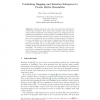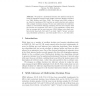216 search results - page 5 / 44 » Decision Tree with Better Ranking |
IDA
2007
Springer
15 years 7 months ago
2007
Springer
Random forests are one of the best performing methods for constructing ensembles. They derive their strength from two aspects: using random subsamples of the training data (as in b...
AAAI
2006
15 years 2 months ago
2006
The majority of the existing algorithms for learning decision trees are greedy--a tree is induced top-down, making locally optimal decisions at each node. In most cases, however, ...
AAAI
2006
15 years 2 months ago
2006
Most existing decision tree inducers are very fast due to their greedy approach. In many real-life applications, however, we are willing to allocate more time to get better decisi...
ICML
1999
IEEE
16 years 1 months ago
1999
IEEE
Before applying learning algorithms to datasets, practitioners often globally discretize any numeric attributes. If the algorithm cannot handle numeric attributes directly, prior ...
107
click to vote
AUSAI
2004
Springer
15 years 6 months ago
2004
Springer
We propose a multivariate decision tree inference scheme by using the minimum message length (MML) principle (Wallace and Boulton, 1968; Wallace and Dowe, 1999). The scheme uses MM...


